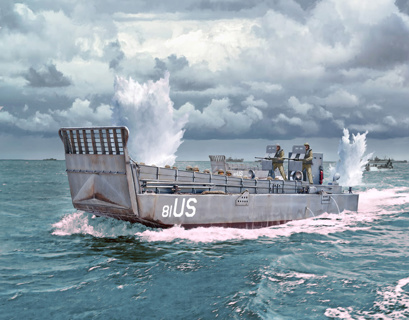LCM3
Item No. 6755
The Landing Craft Mechanized (LCM) is arguably the most famous landing craft in history, its profile intimately linked to Allied amphibious operations in World War II, from Anzio to the beaches of Normandy. The LCM-3 variant is certainly one of the most successful and effectively employed. The desig
Description
The Landing Craft Mechanized (LCM) is arguably the most famous landing craft in history, its profile intimately linked to Allied amphibious operations in World War II, from Anzio to the beaches of Normandy.
The LCM-3 variant is certainly one of the most successful and effectively employed. The design was simple and straightforward yet extremely rational. The large front loading ramp allowed for the rapid disembarkation of a fully armed infantry squad as well as a 30-ton medium Sherman tank.
The armour was very light, protecting the diesel engine, which enabled the LCM to reach a maximum speed of 8 knots, and the crew required for navigation and close defence, consisting of four men. However, significant was its loading capacity and operational flexibility, which allowed the LCM-3 to carve out an important place in 20th-century military history.
The LCM-3 variant is certainly one of the most successful and effectively employed. The design was simple and straightforward yet extremely rational. The large front loading ramp allowed for the rapid disembarkation of a fully armed infantry squad as well as a 30-ton medium Sherman tank.
The armour was very light, protecting the diesel engine, which enabled the LCM to reach a maximum speed of 8 knots, and the crew required for navigation and close defence, consisting of four men. However, significant was its loading capacity and operational flexibility, which allowed the LCM-3 to carve out an important place in 20th-century military history.
LCM3
Item No. 6755
The Landing Craft Mechanized (LCM) is arguably the most famous landing craft in history, its profile intimately linked to Allied amphibious operations in World War II, from Anzio to the beaches of Normandy. The LCM-3 variant is certainly one of the most successful and effectively employed. The desig
Description
The Landing Craft Mechanized (LCM) is arguably the most famous landing craft in history, its profile intimately linked to Allied amphibious operations in World War II, from Anzio to the beaches of Normandy.
The LCM-3 variant is certainly one of the most successful and effectively employed. The design was simple and straightforward yet extremely rational. The large front loading ramp allowed for the rapid disembarkation of a fully armed infantry squad as well as a 30-ton medium Sherman tank.
The armour was very light, protecting the diesel engine, which enabled the LCM to reach a maximum speed of 8 knots, and the crew required for navigation and close defence, consisting of four men. However, significant was its loading capacity and operational flexibility, which allowed the LCM-3 to carve out an important place in 20th-century military history.
The LCM-3 variant is certainly one of the most successful and effectively employed. The design was simple and straightforward yet extremely rational. The large front loading ramp allowed for the rapid disembarkation of a fully armed infantry squad as well as a 30-ton medium Sherman tank.
The armour was very light, protecting the diesel engine, which enabled the LCM to reach a maximum speed of 8 knots, and the crew required for navigation and close defence, consisting of four men. However, significant was its loading capacity and operational flexibility, which allowed the LCM-3 to carve out an important place in 20th-century military history.

